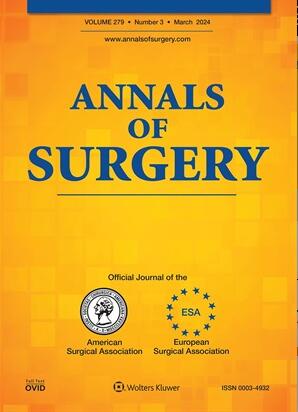传统和新的手术等待时间目标与治疗意图的结直肠癌手术的生存:一项基于人群的队列研究。
IF 6.4
1区 医学
Q1 SURGERY
引用次数: 0
摘要
手术等待时间(WT)是结直肠癌(CRC)常见的质量指标。然而,WT靶点的定义及其与临床相关结果的关系仍然不明确。我们评估了WT与CRC手术与治疗目的手术的总生存率(OS)之间的关系。方法:我们使用加拿大安大略省的卫生管理数据,对2007-2020年间接受I-III期结直肠癌切除术的成年人进行了一项基于人群的回顾性队列研究。暴露量为WT,从决定手术到手术的时间(以天为单位)。结果是OS,以从手术到死亡的时间来衡量。限制性三次样条回归(RCS)检查了WT与死亡危险之间的关系,以确定有意义的WT阈值。然后将WT分类为a)传统WT目标(≤28天)或b) RCS定义的新数据知情目标。多变量Cox比例风险在调整了先验的混杂因素后,探讨了每个WT目标与死亡风险之间的关系。结果在35,533例患者中,27,102例(76.3%)在传统的WT靶内接受了手术。中位WT为19天(四分位数间距12-28)。RCS显示,45天左右出现拐点,死亡风险增加。在调整了年龄、性别、合患、肿瘤部位、分期、新辅助或辅助治疗以及手术年份等因素后,在传统WT目标(≤28天)内进行手术与OS无关(风险比,[HR] 0.97;95%可信区间,[CI] 0.92-1.02)。在新的WT目标(≤45天)内进行手术与较好的OS独立相关(HR 0.90, 95% CI 0.82-0.99)。结论:在I-III期CRC接受治愈性切除术的患者中,在传统WT目标28天内进行手术与OS无关。然而,在WT目标45天内进行手术与较好的OS独立相关。这些数据强调需要通过与临床有意义的结果相联系来重新考虑WT目标的质量监测。本文章由计算机程序翻译,如有差异,请以英文原文为准。
Association of Traditional and new Surgical Wait Time Targets and Survival for Curative-intent Colorectal Cancer Surgery: A Population-based Cohort Study.
BACKGROUND
Wait time (WT) to surgery is a common quality indicator for colorectal cancer (CRC). However, the definition of WT targets and its association with clinically relevant outcomes remains poorly defined. We assessed the association between WT to CRC surgery and overall survival (OS) for curative-intent surgery.
METHODS
We conducted a population-based retrospective cohort study of adults undergoing resection for stage I-III CRC (between 2007-2020), using health administrative data in Ontario, Canada. The exposure was WT, measured as the time from the decision to operate to surgery (in days). The outcome was OS, measured as time from surgery to death. Restricted cubic spline regression (RCS) examined the relationship between WT and hazards of death to identify meaningful WT thresholds. WT was then categorized as a) traditional WT target (≤ 28 days) or b) new data-informed target defined by RCS. Multivariable Cox proportional hazards explored the association between each WT target and the hazards of death after adjusting for confounders established a priori.
RESULTS
Of 35,533 patients, 27,102 (76.3%) underwent surgery within the traditional WT target. The median WT was 19 days (interquartile range 12-28). RCS revealed an inflection point around 45 days associated with increasing hazards of death. After adjusting for age, sex, co-morbidity, cancer site, stage, neo-adjuvant or adjuvant therapy, and year of surgery, having surgery within the traditional WT target (≤ 28 days) was not associated with OS (Hazards Ratio, [HR] 0.97; 95% confidence interval, [CI] 0.92-1.02). Having surgery within the new WT target (≤ 45 days) was independently associated with superior OS (HR 0.90, 95% CI 0.82-0.99).
CONCLUSION
In patients undergoing curative-intent resection for stage I-III CRC, having surgery within traditional WT target of 28 days was not associated with OS. However, having surgery within a WT target of 45 days was independently associated with superior OS. These data highlight the need to reconsider WT targets for quality monitoring by linking to clinically meaningful outcomes.
求助全文
通过发布文献求助,成功后即可免费获取论文全文。
去求助
来源期刊

Annals of surgery
医学-外科
CiteScore
14.40
自引率
4.40%
发文量
687
审稿时长
4 months
期刊介绍:
The Annals of Surgery is a renowned surgery journal, recognized globally for its extensive scholarly references. It serves as a valuable resource for the international medical community by disseminating knowledge regarding important developments in surgical science and practice. Surgeons regularly turn to the Annals of Surgery to stay updated on innovative practices and techniques. The journal also offers special editorial features such as "Advances in Surgical Technique," offering timely coverage of ongoing clinical issues. Additionally, the journal publishes monthly review articles that address the latest concerns in surgical practice.
 求助内容:
求助内容: 应助结果提醒方式:
应助结果提醒方式:


